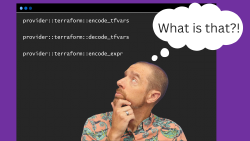


Supercloud - It’s a thing now, so I guess we have to address it.
Crap. I mean yay? In the not too long ago, Chris and I discussed the Supercloud briefly on Chaos Lever as part of a larger discussion of hybrid, on-premises, and other things. My original take was, this is a stupid term someone invented so they could own and promote it. The term adds nothing substantive to the discussion on the future of technology, conflates multiple terms we already lack a solid definition for, and adds a fluffy confusing buzzword to the marketing hell-scape vendors will glom onto and abuse until the term is more meaningless than it started.
And yet it persists.
Since we can’t simply nuke it from orbit, I suppose we must engage head-on with a robust examination on the origin of the term; the evolving use of the term; a working definition that is entirely too long; and the popularity of the term now and in the future. But first a word from our sponsor PedanTree:
“Tired of being an easy going person people enjoy talking to at social gatherings? Exhausted by the constant bother of interfacing with fellow human beings? Sick of being pleasant and reasonable at company retreats? Try pedantry, a product of Misanthropy Inc. With pedantry, you can annoy even the most well intentioned person by correcting their grammar. You can lose and alienate loved ones by picking apart their sentence structure. You could even be ostracized by critiquing your friend’s pronunciation. Yes pedantry is here to make your life as lonely and miserable as possible. Sign up now and we’ll send you a hefty supply of grammar nazi absolutely free!”
I’ve reached a point in my life and career where I’ve recognized that being pedantic and exacting about language is not always the best solution. Are there situations that call for using your lexicon with exacting precision? Certainly. Is that situation a casual conversation with a colleague or friend? No. Words mean things, but what they mean is constantly evolving and changing based on how humans use language. There’s no right way, except what we’ve collectively decided is right. Remember, language isn’t physics or mathematics. There’s no natural law or inherent rules, just humans being silly and trying (badly) to communicate with each other.
For the most part I’ve stopped correcting people on the use of on-premises vs. on premise. I don’t really care whether you’ve capitalized VMware properly (and neither does OneNote BTW). And I’ve just accepted that AI and ML, like literally and figuratively, are going to be used interchangeably, and in most situations that’s fine. It’s FINE. The point of words is to communicate meaning effectively. If your words are doing that, then we can all step back from the bully pulpit.
We invent terms when we encounter a person, place, or thing that we don’t already have a term for. That could be an existing idea or product that is expressed in a unique way, where the previous terminology no longer applies. Or it could be a wholly new thing that requires the invention of a term. Machine Learning, for instance, was something that didn’t exist until the mid 20th century, and so a new term had to be invented to describe what was happening. New terms are not bad, per se, they are a much needed component of any language. The best new terms are intuitive, provide clarity, and have an established definition we can all agree on.
And yet Supercloud really chaps my ass. Part of this post is attempting to define Supercloud and how it’s used, but the other part is a personal exploration of why this term bothers me SO MUCH.
I’d like to first acknowledge that the term supercloud has been around since at least 2016, and if you Google/DDG it you will get a website from Cornell that is an actual software project to allow for application migration between clouds. The second hit is to an MIT webpage about a project they called supercloud that was meant to enhance collaboration between MIT Lincoln labs, students, and faculty. My point is that the term is not new, but we can trace the origin of its use in the current context back to a post on the SiliconAngle website called The rise of the supercloud, which is not written in titlecase just to poke the pedant in me a little more.
If you’re not familiar with SiliconAngle (and hey if they can’t capitalize things right, then I can’t be bothered with their name’s capitalization either), they are an industry analysis and news firm probably best known for theCUBE (fine I’ll do it, but I won’t enjoy it) which is usually recorded live at various tech conferences, with hosts like Dave Vallente and John Furrier chatting with vendors, other analysts, or themselves about what’s going on in the industry.
The folks at siliconANGLE (see, I said I’d do it) have a ton of industry experience, and this post is not meant to impugn on their credentials or disparage their personal brands. They are kind people who I’ve only had positive experiences with. Nevertheless, Supercloud.
As someone who has done some work as an analyst, your primary job is to make shit up with the intent of promoting your brand or firm. For example, consider the Magic Quadrant from Gartner. You know it, you “love” it? You might even think there’s some hard science behind it. I assure you, there is not. For all the talk of qualitative vs. quantitative measurement of vendor products, most of it is a gut feeling and a guess. Analysts have to take multiple briefings a week from vendors, and they absolutely do not have time to test drive any of these solutions. In most cases, they try to apply a skeptical eye on what each vendor tells them, but not too skeptical because they need to stay in the good graces of the vendor if they want future briefings. So they take the briefing, maybe read some of the white papers, peruse the website and then do a write up.
Analyst firms make money by selling their analysis to companies who don’t want to or can’t do the research on their own. They also make money by doing research for the same vendors they are supposed to be impartially judging. Look, it’s a weird industry, and I am not accusing anyone of unethical behavior. You can maintain your morals and still get paid, but it still introduces the potential for pay-to-play and other below board behavior.
Jesus, that was quite a tangent. Why did I even get into all of that? Oh, right, the Supercloud. Analyst firms need you, the customer, to trust what they are saying. They need to be thought leaders. They need to be on the cutting edge of what’s happening in the industry. And there’s no better way to do that than making up a new term and convincing everyone else it’s useful and relevant. Gartner has its Magic Quadrant, Forrester has The Wave, and I guess siliconANGLE has rolled out the Supercloud.
Why Supercloud? Did we not already have enough cloudy terms? Let me give a few examples.
Hybrid cloud - Running applications in your datacenter and in a public cloud Multicloud - Running applications in multiple clouds Private cloud - Running applications in non-public cloud Public cloud - Running applications on a public-cloud (multitenant) environment Community Cloud - Running applications in a cloud that has really strict rules about who can use them Fuuuuuuuu Cloud - How I feel every morning.
We’ve got a lot of terms that define ways to deploy and manage applications. All of them seem to have this cloud term attached. What’s that all about? The term cloud has been used into oblivion, but personally I tend to think of it as an operational model more than anything else. It’s about automation, elasticity, self-service, and measuring consumption. You know, that old NIST definition ain’t so bad.
Supercloud as a term came to exist because siliconANGLE analyst John Furrier was trying to invent a term to describe a trend he and others had observed in the tech landscape. Simply put, there were a bunch of technology vendors building new platforms based on the primitives of the public cloud vendors (aka AWS, Azure, GCP) and offering their higher level abstraction to customers as an alternative to building it yourself. If that sounds suspiciously like SaaS (Software as a Service), you’re not wrong.
I, too, had been noticing the trend of what I would call cloud-native companies and products that aren’t SaaS in the traditional sense, but are using public cloud primitives to build out their platform. When I say platform, I am talking about a technology or service another company would use to build a product or application leveraged by end users. In the same way that Oracle has a database platform used by thousands of companies to build their applications, Supercloud offerings would do the same but with the added benefit of offering it as a service.
The cognitive dissonance here lies in the difference between a platform and an application. And I’ll be the first to admit that it is a tenuous distinction that harkens back to the old defense of “I know it when I see it.” Maybe some examples are in order. Snowflake has built a data warehouse and analytics platform that sits astride the public cloud providers. Your average end user would not interface directly with Snowflake. Instead they might use an application that leverages the Snowflake platform, but that is abstracted or hidden from the consumer. Another example is Aviatrix, who is building a multicloud networking abstraction platform. You might use it as the transport platform for your applications, but it would never be customer facing.
Traditional SaaS, on the other hand, is customer facing. Canva, Office 365, Netsuite, etc. All of these offerings are consumed by non-technology professionals to get their work done. In some cases, solutions like Salesforce.com have also drifted into the platform territory, as I said the line in the distinction is tenuous. You could make the same argument about PowerApps on Microsoft 365 and I would concede the point. As Einstein would say, “It’s all relative, now leave me alone I have a grand unified theory to work on. Also, I’m dead.”
There is a working group definition of Supercloud you can check out which attempts to put some formal constraints around what the term Supercloud is intended to mean. They lay out three key characteristics or essential properties that a Supercloud offering would have to include: Run a set of services across more than one cloud (maybe), purpose-built super-paas layer (a new term! fun.), metadata intelligence.
The first one is fairly intuitive. The second one includes a new made up term called SuperPaaS, which no. Just no. Stop it. The term is trying to describe a platform that spans multiple clouds and hides the underlying cloud primitives. That’s what a platform is. Platforms abstract the underlying components, whether it’s a set of cloud providers or virtualization hosts. We already have a word. We don’t need a new one. If you want to be more precise, add a descriptor like cross-cloud or multicloud.
The third essential property simply means that the Supercloud offering is aware of its underlying components and can make informed decisions based on regionality, cost, etc. That’s um. That’s still just a platform, friend. Any platform that was unaware of its underlying components would be a pretty terrible platform.
There are also three deployment models: single cloud instantiation (which seems to contradict the first essential property), multi-cloud/multi-region, and global instantiation. No mention of transubstantiation. Weird.
Trying to pick those deployment models apart, the key here is control plane versus data services. The deployment model is mostly referring to how the control plane is deployed. As the consumer, I shouldn’t have to care. Give me the correct number of 9’s and everything else is an implementation detail. Does Office 365 tell me where the control plane is running? No. Do I care? No.
That’s it. That’s the big definition. Supercloud is a distributed platform used to build applications from abstracted cloud primitives. It’s a platform for building applications. It’s a platform… ever say a word so many times it starts to lose meaning? Platform. Orange. Toy boat. Toy boat. Toy boat.
Does this new term need to exist? No.
Sweet, post over.
JK!
In the working definition document, they address my question in the FAQ, and I thought I would quote from it:
“There is broad agreement that clouds in the 2020s are different from clouds of the 2010s. That something new is happening within the AWS (and other) cloud ecosystems, beyond traditional IaaS and PaaS and isn’t just SaaS running in the cloud. Supercloud is an attempt to describe a new architecture that integrates infrastructure, unique platform attributes and software to solve specific problems that public cloud vendors aren’t directly addressing. Supercloud is an evocative term that catalyzes debate, conversation and thought.”
It’s a term for stirring the pot. It’s a term that elevates the profile of those who invented it. It’s a term that can be trademarked and used for marketing purposes if desired. It’s a term that is both useful for debate and useless for anything practical. It’s the “Change my mind” Stephen Crowder meme, worse yet, it might even be the Ben Shapiro of cloud terms. Too far? Yeah, that might be too far.
And shit, it’s working! I’m talking about it. Supercloud was discussed in an IT Roundtable at Cloud Field Day 15. I’ve heard it mentioned on podcasts, in articles, and blog posts. Most of them are dismissive of the term at best. But they are engaging. Does that make me culpable? Am I part of the problem? (Sigh). I guess we’re all pundits now.
If you’re an analyst or a marketing firm, you can use Supercloud to imply or imbue some mystical properties on a product or service. Leverage the Supercloud with PendaTree from Misanthropy Inc!
But is it useful to practitioners? Probably not. If I am an application architect and I need a data platform, I can evaluate Snowflake, AWS Aurora/RedShift, and Oracle and decide which one meets my requirements without throwing some weird terminology into the mix. If I’m working on the platform team in an enterprise, I might be interested in a supercloud-type product to integrate into the platform I offer to the product teams in my org. But again, the term doesn’t help me in any meaningful way.
Does it group similar offerings into a category where they can be compared fairly on their merits? Not really either. What does NetApp vs. Snowflake vs. VMware have to do with each other? Supercloud is grouping together disparate product offerings and rolling them into a useless category for comparison and evaluation. I think it fails as an analytical term too.
At the end of the day, Supercloud is a marketing term with a touch of self-promotion from siliconANGLE. It doesn’t describe a new thing, it doesn’t provide clarity in our communications, and it has no utility for practitioners. And I’m happy to never mention it again.
Using Provider Defined Functions in Terraform
July 18, 2024

Variable Validation Improvements in Terraform 1.9
July 8, 2024

July 6, 2024
